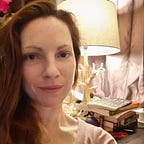Book Review — Having Faith: An Ecologist’s Journey to Motherhood
I cannot recommend Having Faith: An Ecologist’s Journey to Motherhood enough. Sandra Steingraber does a wonderful job of balancing science and prose, a very difficult task especially since she goes into such marvelous depth in regards to the science. The book was informative, engaging, and encourages readers to action, to be advocates for their own health.
The book is divided into two main parts. In the first, each chapter focuses on a month of Steingraber’s pregnancy. The second part of the book focuses on what happens to her after the baby is born and the science that accompanies that time period, as with breastfeeding.
Steingraber weaves her own experiences of what happened to her and her body during that month with the science of what’s going on. For example, in Chapter 4, Egg Moon, she discusses some of the implications of DDT on developing fetuses. By intermixing prose and science, the science is easier to digest without becoming too dry, and the author’s experiences help make the science seem more real and grounded in things that actually happen to real people rather than just seeming like statistics that have no bearing on the real world.
In addition to shining a light on chemicals that affect us, and thereby our children, Steingraber notes some things that we can do to help reduce the effects of such chemicals on pregnant women. One of her biggest points in the book, though, is that we as pregnant women shouldn’t have to know all of this stuff that could potentially harm us and our children; we should be able to drink water and eat fish without abstaining from things that should be good for us were it not for the contamination in them. Instead, the polluters and contaminators should be held accountable and restricted so that our environment is safe. Steingraber encourages readers to become advocates for their own health and for the health of others, including unborn children.
A movie, Living Downstream, was made based on one of her other books by the same title. A trailer for the movie is below.
Steingraber has a website, and she notes resources that are useful for finding out more about the things we use or could come into contact with that could pose health threats.. Some of the sites she notes that I found useful are:
- Beyond Pesticides — A nonprofit that works with allies in protecting public health and the environment to lead the transition to a world free of toxic pesticides. It believes that people must have a voice in decisions that affect them directly and that decisions should not be made for us by chemical companies or by decision makers who either do not have all of the facts or refuse to consider them. They have a Shop page with signs noting a pesticide-free yard, which I find adorable and useful for letting my neighbors know that that’s important to me (and maybe encourage them to use fewer pesticides, too…).
- Chemicals Health Monitor — Provided by the Health and Environment Alliance (HEAL), a European not-for-profit organization addressing how the environment affects health in the European Union (EU). The project wants to provide authoritative information (in a form accessible to the nonspecialist public!) to support measures to reduce harmful effects of hazardous chemicals on human health and the environment, and to choose safer alternatives. The Take Action page in particular has some useful information.
- Pesticide Action Network North America (PANNA) — works to replace the use of hazardous pesticides with ecologically sound and socially just alternatives.
- The Right-to-Know Network — A project by the Center for Effective Government, it advocates push for improved access to government-held information on the environment, health, and safety. Provides a lot of environmental data, as does the Toxic Release Inventory, which I mentioned in a previous post.
- Silent Spring Institute — It partners with physicians, public health and community advocates and other scientists to identify and break the links between environmental chemicals and women’s health, especially breast cancer. They have a new publication online called Too Close to Home, which notes certain ways you may be exposed to chemicals during your everyday life.
- The Stockholm Convention -The United Nations organized the treaty, which seeks to phase-out use of certain chemicals, persistent organic pollutants (POPs). I find it inexcusable that the U.S. is one of the few countries that has not ratified the treaty.
- The Story of Stuff Project — Their online movies explore where everyday products comes from, like bottled water, and examines the underlying roots of our unsustainable production and consumption patterns: what makes the system tick, who pays, who benefits and how can we turn it around.
- Toxipedia — a free toxicology encyclopedia offering articles and resources about toxic chemicals (such as pesticides and endocrine disruptors), health conditions, ethical considerations, the history of toxicology, laws and regulation, and more. Their goal is to provide scientific information in the context of history, society, and culture so that the public has the information needed to make sound choices that protect both human and environmental health.
